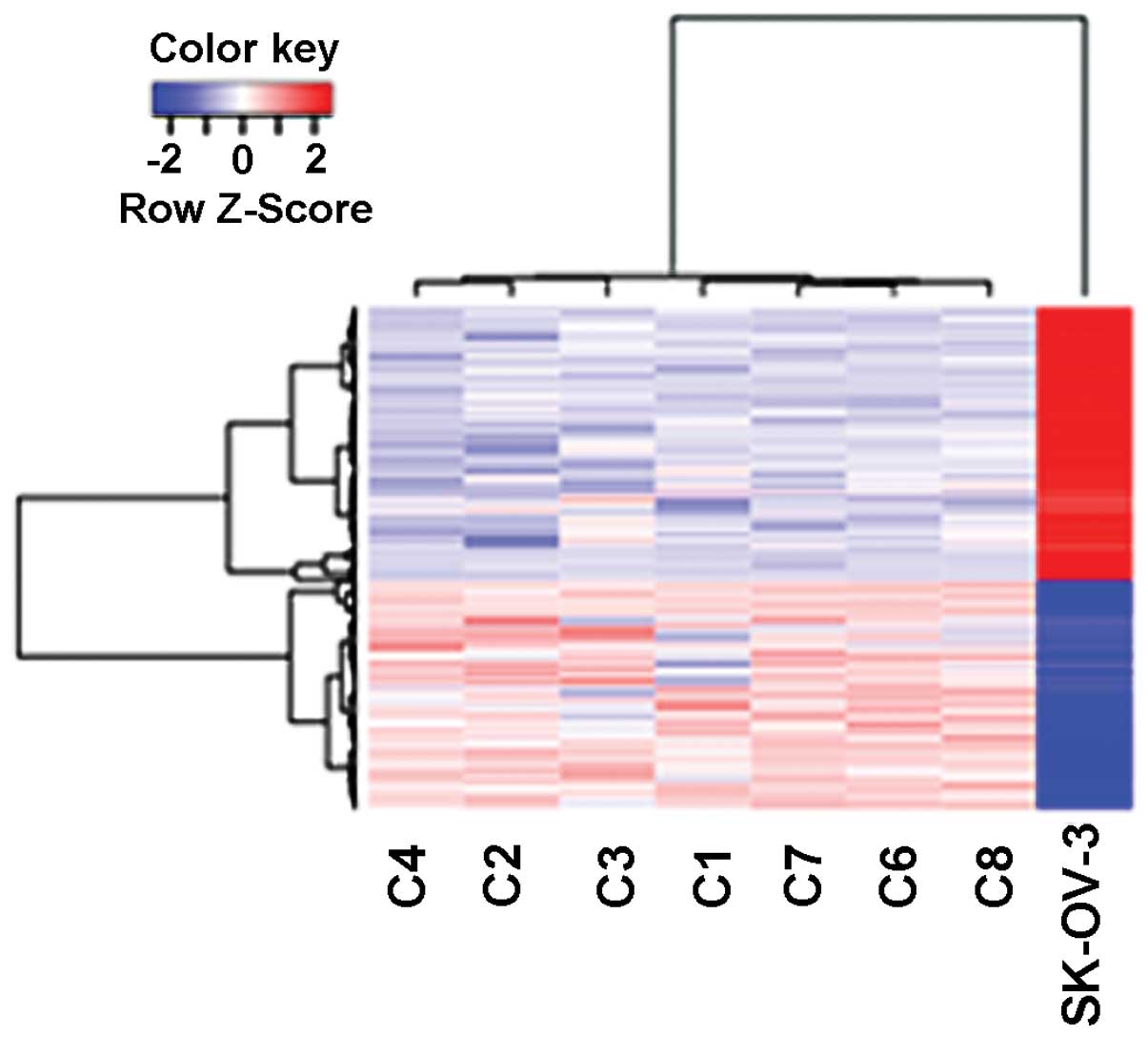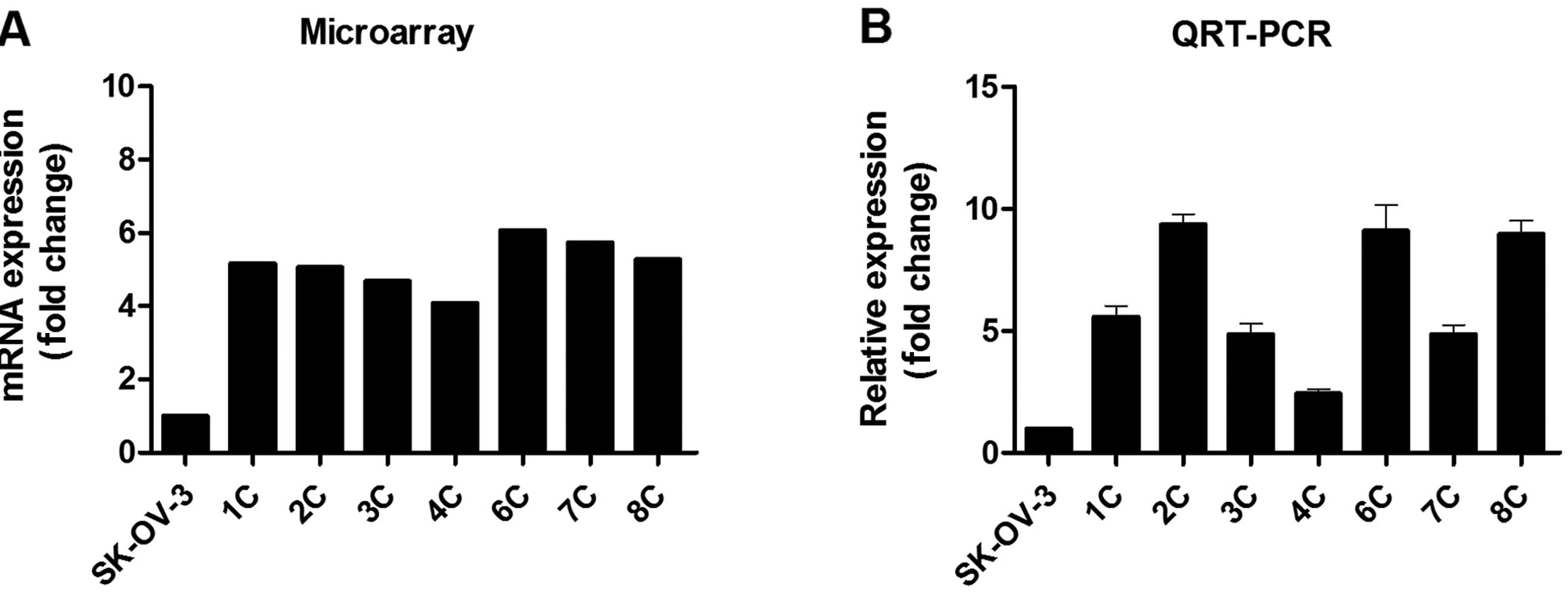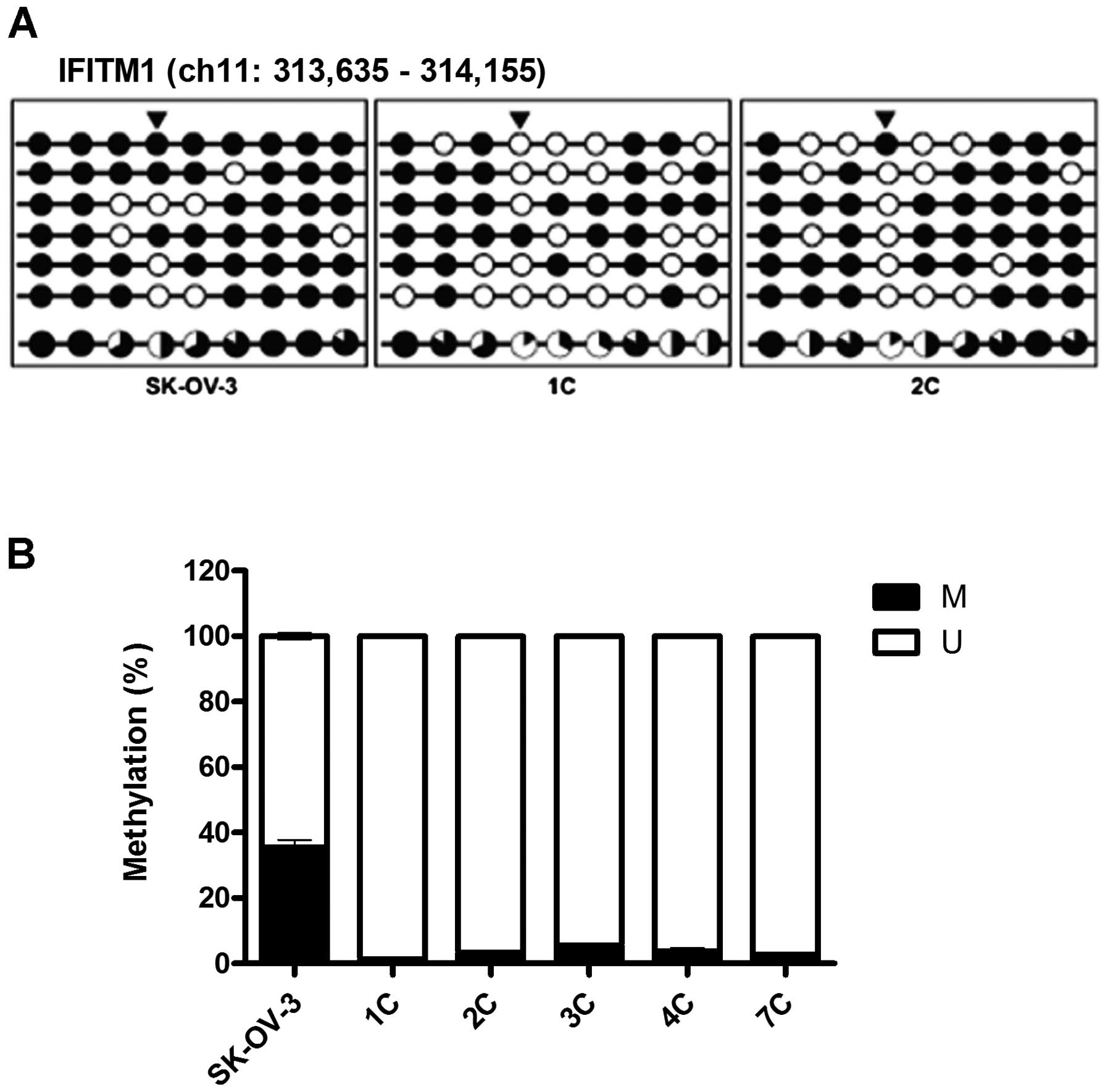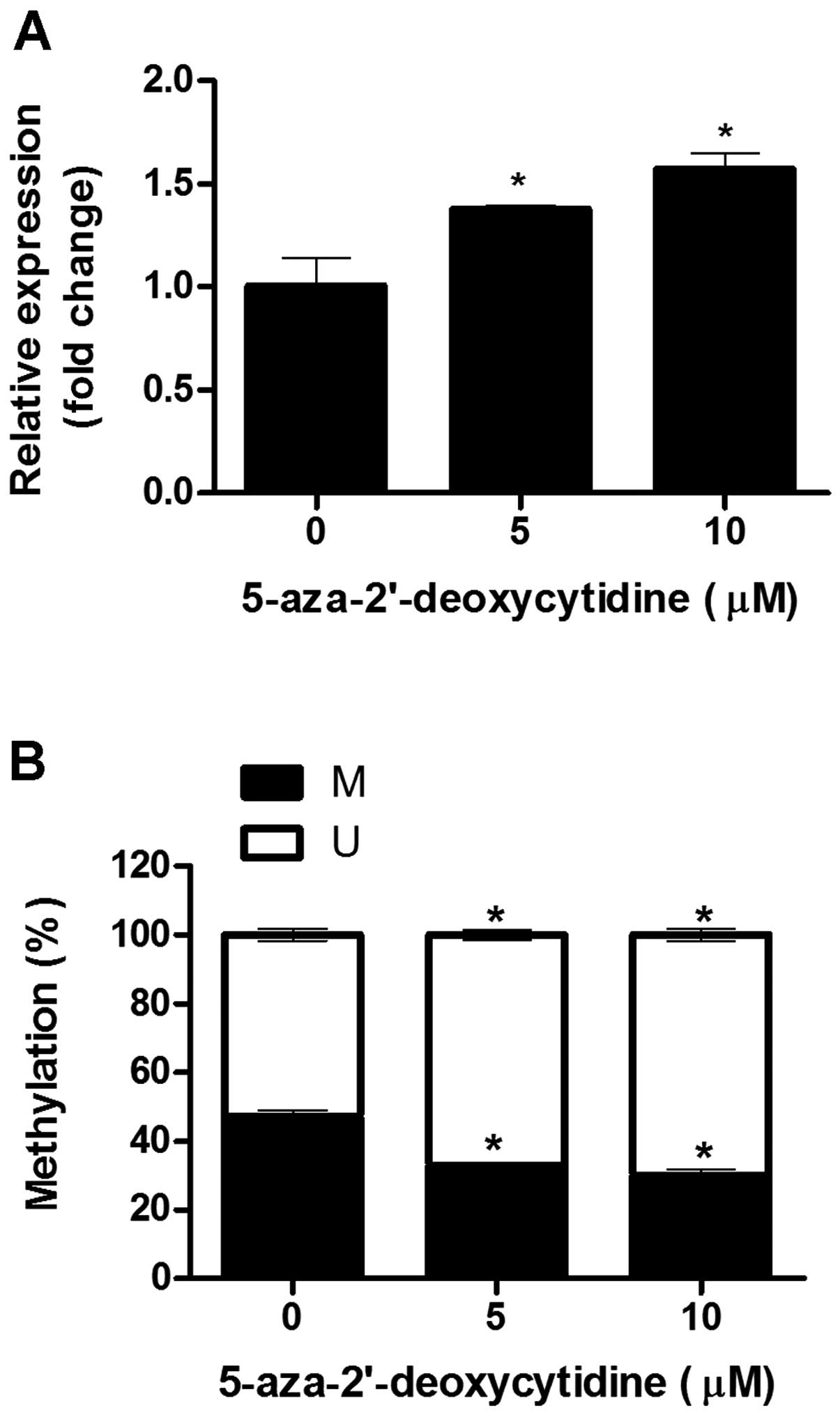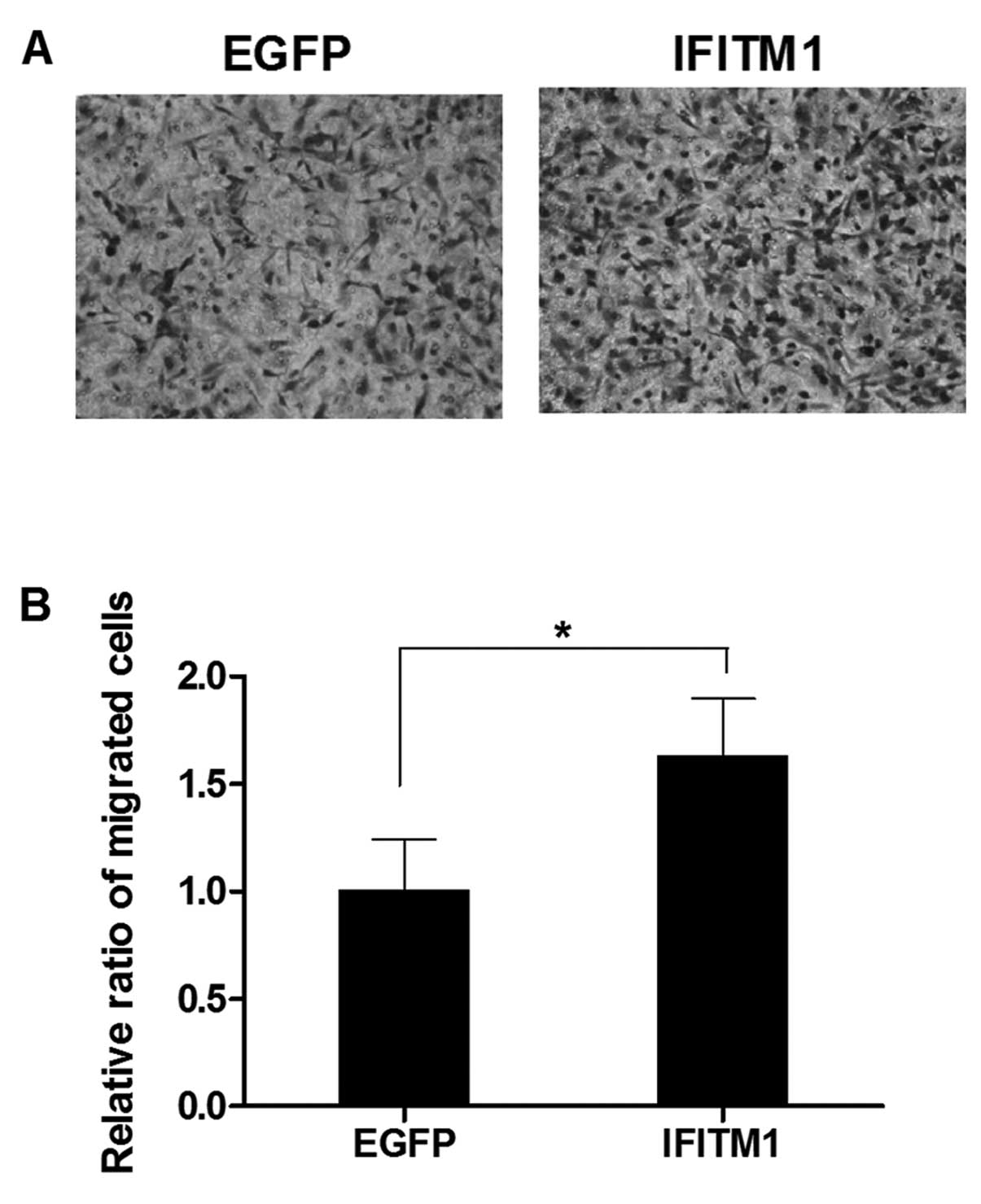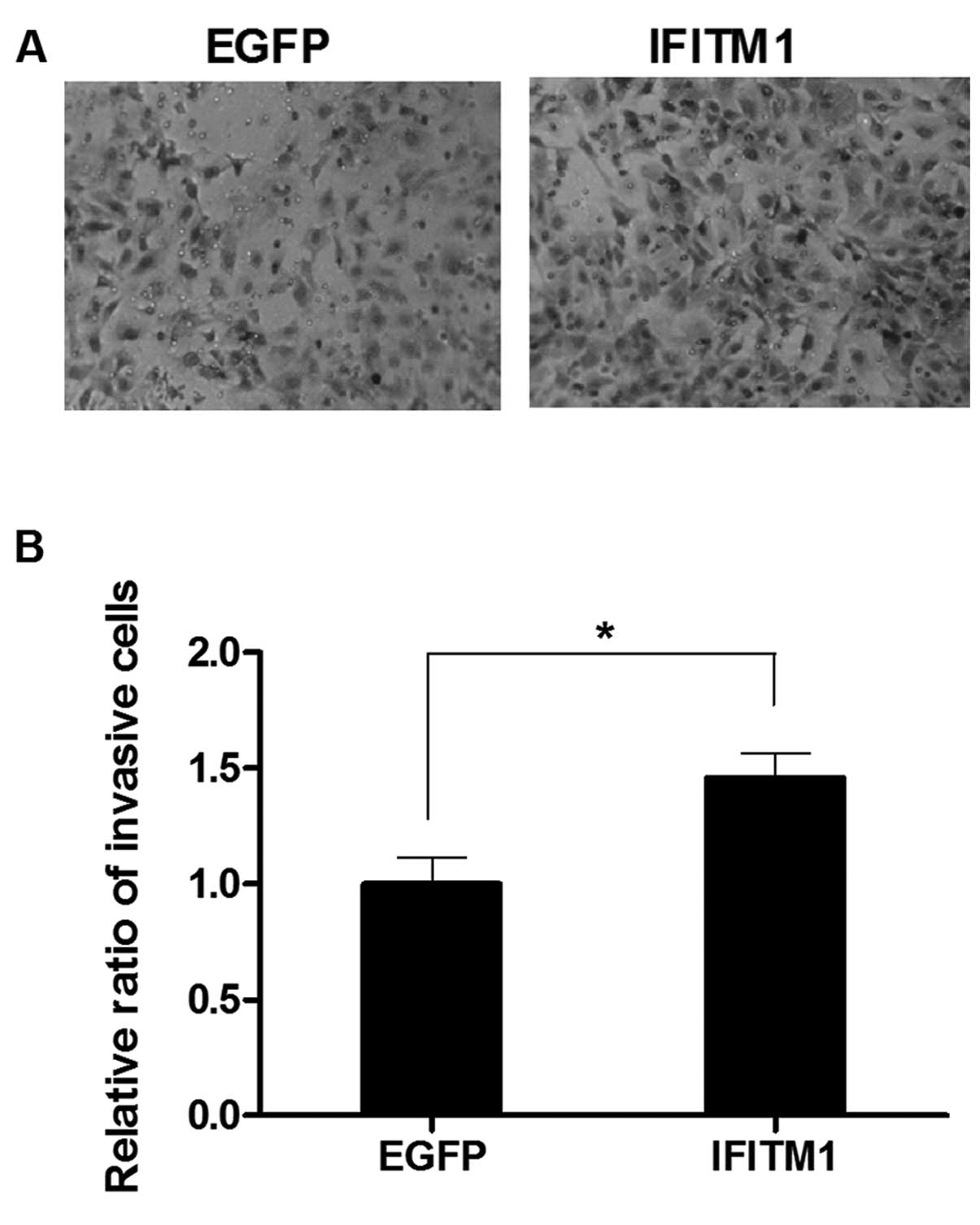Aberrant DNA methylation in the IFITM1 promoter enhances the metastatic phenotype in an intraperitoneal xenograft model of human ovarian cancer
- Authors:
- Published online on: March 24, 2014 https://doi.org/10.3892/or.2014.3110
- Pages: 2139-2146
Abstract
Introduction
Despite progress in cancer therapy, ovarian cancer remains the most lethal gynecological cancer. Since there is no reliable biomarker for early detection, and the early stages of the disease are mostly asymptomatic, the majority of patients with ovarian cancer are diagnosed when the disease is in advanced stages, and the 5-year survival rate is less than 20% (1). The high mortality rate in ovarian cancer is also linked to a high recurrence rate. Over 70% of patients with ovarian cancer suffer from recurrence within 2 years of primary standard treatment, which includes total hysterectomy with bilateral salpingo-oophorectomy and subsequent chemotherapy (2). All ovarian cancer recurrences following primary treatment are metastatic recurrences.
Ovarian cancer metastasis has a unique biological behavior that differs from the classical patterns of metastases spreading through the vasculature. Ovarian cancer cells disseminate primarily in the peritoneal cavity and subsequently implant onto mesothelial surfaces (3). The biological process of metastasis is complex at the molecular level, involving adhesion, migration, invasion, growth, proliferation and apoptosis. Understanding the molecular mechanisms of ovarian cancer metastasis will likely lead to novel therapeutic targets and biomarkers that will facilitate better predictions of prognosis.
Interferon-induced transmembrane protein 1 (IFITM1) is a member of the interferon-induced transmembrane protein family and is important for antiproliferative and homotypic-adhesion signal transduction in lymphocytes (7–9). IFITM1 also has antiviral functions, inhibiting influenza A replication and enveloped virus infection (10). IFITM1 is upregulated in diverse tumor tissues and cell lines (11–14) and promotes migration and invasiveness in gastric cancer (15,16), glioma (14) and head and neck cancers (17). Furthermore, IFITM1 is reportedly upregulated in response to the anticancer drug paclitaxel in ovarian carcinoma xenografts; however, the role of IFITM1 and the mechanisms that regulate its expression in ovarian cancer have not yet been elucidated.
Human ovarian carcinoma xenografts are useful tools for analyzing tumorigenicity and for testing the efficacy of newly developed therapies in vivo (3). In particular, intraperitoneal or orthotopic xenografts are useful for modeling the advanced stages of ovarian carcinomas (3). These xenografts produce carcinomatosis in the peritoneal cavity, with large volumes of ascites resembling human ovarian metastatic phenotypes (4–6). We established a mouse xenograft model of human ovarian carcinoma and analyzed transcriptional expression in metastatic implants from the xenografts. The expression pattern of the metastatic implants reflected the pathophysiological condition of ovarian metastatic phenotypes in humans. We selected IFITM1 from among the upregulated genes in the metastatic implants and investigated the mechanism regulating IFITM1 expression.
Materials and methods
Cell culture
The human ovarian cancer cell line SK-OV-3 was purchased from the American Type Culture Collection (ATCC; no. HTB-77) and cultured in McCoy’s 5A medium containing 10% fetal bovine serum (FBS), 100 U/ml penicillin and 100 μg/ml streptomycin (all from Gibco-BRL) in a 95% humidified air and 5% CO2 atmosphere at 37°C.
Ovarian cancer mouse xenograft model
All procedures for handling and euthanizing the animals used in the present study were performed in strict compliance with the guidelines of the Korean animal protection law and were approved by the Institutional Animal Care and Use Committee (IACUC) of Ewha Womans University School of Medicine. SK-OV-3 cells (2×106) suspended in culture media were intraperitoneally injected into 10 female nude mice (BALB/c, 4–6 weeks of age). Four weeks after inoculation, the xenograft mice were sacrificed, and at least four implants adhering to the mesothelial surface of each mouse were harvested.
RNA preparation and quantitative reverse-transcription polymerase chain reaction (qRT-PCR)
Total RNA was extracted from the metastatic implants of the ovarian cancer mouse xenografts and SK-OV-3 cells using the RNeasy Mini kit (Qiagen) according to the manufacturer’s protocol. One microgram of total RNA was converted to cDNA using SuperScript II reverse transcriptase and oligo-(dT)12–18 primers (both from Invitrogen) according to the manufacturer’s instructions. qRT-PCR was performed in a 20-μl reaction mixture containing 1 μl cDNA, 10 μl SYBR Premix Ex Taq, 0.4 μl ROX Reference Dye (50X) (both from Takara Bio), and 200 nM primers for each gene. The primer sequences were: IFITM1 (forward), 5′-CGCCAAGTGCCTGAACATCT-3′ and IFITM1 (reverse), 5′-TACCAGTAACAGGATGAATCCAATG-3′; GAPDH (forward), 5′-AATCCCATCACCATCTTCCA-3′ and GAPDH (reverse), 5′-TGGACTCCACGACGTACTCA-3′. The reactions were run on a 7500 Fast Real-Time PCR System (Applied Biosystems) at 95°C for 30 sec, followed by 40 cycles of 95°C for 3 sec and 60°C for 30 sec, and a single dissociation cycle of 95°C for 15 sec, 60°C for 60 sec, and 95°C for 15 sec. All PCR reactions were performed in triplicate, and the specificity of the reaction was detected by melting-curve analysis at the dissociation stage. Comparative quantification of each target gene was performed based on cycle threshold (Ct) normalized to GAPDH using the ΔΔCt method.
Messenger RNA microarray chip processing and analysis of gene expression data
Total RNA was extracted from the harvested metastatic implants of the ovarian cancer mouse xenografts and SK-OV-3 cells using the RNeasy Mini kit, and 1 μg of total RNA was amplified and labeled according to the Affymetrix GeneChip Whole Transcript Sense Target Labeling protocol. The resulting labeled cDNA was hybridized to Affymetrix Human Gene 1.0 ST arrays (Affymetrix). The scanned raw expression values were background corrected, normalized and summarized using the Robust Multi-array Average approach in the Bioconductor ‘affy’ package (Affymetrix). The resulting log2-transformed data were used for further analyses.
To identify differentially expressed genes (DEGs), we applied moderated t-statistics based on an empirical Bayesian approach (11). Significantly upregulated and downregulated DEGs were defined as genes with at least a 2-fold difference in expression level between the xenograft cells and the wild-type SK-OV-3 cells after correction for multiple testing [Benjamini-Hochberg-false discovery rate (BH-FDR)-adjusted p-value <0.05] (18). Finally, we excluded genes with a low expression level (maximum log2 expression level in a total of 8 samples <7.0) from the list of DEGs. The DAVID bioinformatics resource was used to detect overrepresented GO clusters from the identified DEGs (13).
Bisulfite sequencing PCR (BSP)
Genomic DNA was extracted from the harvested metastatic implants of the ovarian cancer mouse xenografts and SK-OV-3 cells using the QIAmp DNA Mini kit (Qiagen) according to the manufacturer’s protocol. Bisulfite treatment of genomic DNA was performed using the EpiTect Bisulfite kit (Qiagen) according to the manufacturer’s instructions. For bisulfite sequencing of the target promoter region of IFITM1, BSP was carried out using conventional PCR in a 50-μl reaction mixture containing 10 ng bisulfite-modified genomic DNA, 1.5 mM MgCl2, 200 μM dNTP, 1 U Platinum Taq polymerase (Invitrogen), 1X Platinum Taq buffer, and 200 nM specific BSP forward and reverse primers for each gene. The BSP primers were designed using the MethPrimer software (http://www.urogene.org/methprimer). For IFITM1, the BSP product was 522 bp (position in the human GRCh37/hg19 assembly: ch11 313,635-314,156) and contained 9 CpG sites. The BSP primer sequences were: (forward), 5′-GGATTGTAGTTTGAGGAAAGAGTAAG-3′ and (reverse), 5′-AAAAAAAATATTAAATAAAAATTTA AAAAA-3′. The reaction was run at 95°C for 5 min, followed by 30 cycles of 95°C for 30 sec, 50–55°C for 30 sec, and 72°C for 30 sec and a final elongation step at 72°C for 5 min.
The BSP products were purified using the QIAquick Gel Extraction kit (Qiagen) according to the manufacturer’s protocols and ligated into the yT&A cloning vector (Yeastern Biotech). The ligation products were used to transform competent DH5α Escherichia coli cells (RBC Bioscience) using standard procedures. Blue/white screening was used to select bacterial clones, and BSP product-positive clones were confirmed by colony PCR using the BSP primers to verify the insert size. Plasmid DNA was then extracted from at least 15 insert-positive clones using the QIAprep Spin Miniprep kit (Qiagen) and sequenced using the M13 primer to analyze the methylation status at specific CpG sites.
Quantitative methylation-specific PCR (qMSP)
Quantitative MSP was carried out with bisulfite-modified genomic DNA as the template and specific primer sequences designed to detect the methylated and unmethylated forms of IFITM1. The following methylated/unmethylated-specific primers were used: (forward), 5′-TAGGAAGTTATTAGTTTTGATTTG AGT-3′; (methylated reverse), 5′-TAAAACCTCCTTTCCC CTATCG-3′ and (unmethylated reverse), 5′-TAAAACCTCC TTTCCCCTATCA-3′. For qMSP, a 20-μl reaction mixture containing 2 μl (10–100 ng/μl) bisulfite-treated DNA, 10 μl SYBR Premix Ex Taq (Takara Bio), 0.4 μl ROX Reference Dye (50X; Takara Bio), and 200 nM each primer were reacted using a 7500 Fast Real-Time PCR system (Applied Biosystems). The amplification reaction conditions were: 95°C for 30 sec, followed by 40 cycles of 95°C for 3 sec, and 62°C for 30 sec. The PCR product was then reacted at 95°C for 15 sec, 60°C for 1 min, and 95°C for 15 sec to examine the specificity. Methylation and non-methylation of the specific CpG sites were calculated as follows (Ct represents the threshold cycle): Percent methylation = 100/[1 + 2(ΔCtmeth − ΔCtnonmeth)].
Treatment with 5-aza-2′-deoxycytidine (5-aza-dC)
To demethylate the methylated CpG sites, SK-OV-3 cells were treated with an increasing concentration (0, 5 and 10 μM) of 5-aza-dC (Sigma-Aldrich) for 3 days. The medium was replaced daily.
Transient transfection
To establish a transient expression system, SK-OV-3 cells were transfected with pCMV6-XL5-IFITM1 (Origene) or pEGFP-N3 (Clontech) plasmid DNAs using Lipofectamine™ 2000 (Invitrogen). Briefly, the cells were plated at a density of 6×105 cells/well in 6-well plates and allowed to grow overnight. Two micrograms of each plasmid DNA and 5 μl Lipofectamine 2000 were diluted separately in Opti-MEM medium to a total volume of 250 μl. The diluted plasmid DNAs and Lipofectamine 2000 were mixed and incubated at room temperature for 20 min to generate the transfection mixtures. The cells were washed with serum-free McCoy’s 5A medium, and then the transfection mixtures were added to each well of the 6-well plates containing complete growth medium and incubated at 37°C for 24 h in a 5% CO2 incubator.
Transwell migration and in vitro invasion assay
After 24 h of transfection, the transfected cells were starved by serum deprivation. The cell migration assay was performed in 24-well Transwell plates containing inserts with a polycarbonate membrane with an 8.0-μm pore size (Corning). After 24 h of serum deprivation, the cells were detached from the plates and resuspended in serum-free medium at a density of 2×106 cells/ml. One hundred microliters of the SK-OV-3 cell suspension was added to the upper compartment of the Transwell chamber. For each experiment, both chemotactic migration to medium containing 15% FBS and random migration in serum-free medium were assessed in parallel Transwell plates for 6 h at 37°C in a 5% CO2 incubator.
The in vitro invasion assay was performed using a BD BioCoat Matrigel Invasion Chamber (Becton-Dickinson). After 24 h of serum deprivation, SK-OV-3 cells were detached from the plates and resuspended in serum-free medium at a density of 1×106 cells/ml. One hundred microliters of the SK-OV-3 cell suspension was added to the upper compartment of the invasion chamber, and 500 μl McCoy’s 5A medium containing 10% FBS was added to the lower compartment of the chamber. The migration through the Matrigel chamber was allowed to proceed at 37°C for 24 h in a 5% CO2 incubator. After the incubation period, the cells that had not migrated from the upper side of the filter were carefully scraped away with cotton swabs. The cells on the lower side of the filter were fixed for 2 min using Diff-Quick kit solution (Fisher Scientific), stained with 1% crystal violet for 2 min and washed twice with distilled water at room temperature. The images of the stained cells on the lower side of the membrane were acquired at ×200 magnification in six different fields. For quantitative analysis, the stained cells were subsequently extracted with 10% acetic acid, and colorimetric measurement was performed at 590 nm.
Results
Identification of DEGs
A total of 973 genes were found to be differentially expressed in the xenografts relative to the SK-OV-3 cells (Fig. 1). The 444 DEGs that were upregulated were enriched with genes involved in cell adhesion, blood coagulation and wound healing, response to steroid hormone stimulus, blood vessel development and cell mobility (Table I). The 529 DEGs that were downregulated were enriched with genes related to the inflammatory response, regulation of programmed cell death and response to endoplasmic reticulum stress (Table I).
Validation of altered IFITM1 expression
From among the 444 upregulated DEGs, we selected IFITM1 as a representative gene to validate the expression microarray results, and we confirmed its expression with qRT-PCR. In agreement with the expression microarray results, IFITM1 mRNA expression was profoundly (2.4- to .4-fold) upregulated in the metastatic implants from the ovarian cancer xenografts (n=7) compared with that in the wild-type SK-OV-3 cells (Fig. 2).
DNA methylation regulates the expression of IFITM1
The promoter-region CpG sites in the ovarian metastatic implants were found to be hypomethylated when compared with those in the SK-OV-3 cells, particularly the CpG sites at −272, +54, +84 and +96 (Fig. 3A). Further analyses of DNA methylation using MSP revealed significantly reduced methylation at the +54 CpG site in the ovarian metastatic implants (Fig. 3B). Following treatment with 0, 5 and 10 μM 5-aza-dC, decreased methylation activity at the +54 CpG site was confirmed using MSP; and in parallel, the expression of IFITM1 mRNA was significantly increased in a dose-dependent manner (Fig. 4).
IFITM1 overexpression induces the migration and invasion of the ovarian cancer cells
To examine the effect of altered IFITM1 expression on metastasis, we performed in vitro migration and invasion assays using Transwell chambers. SK-OV-3 cells were transfected with full-length IFITM1 or enhanced green fluorescence protein (EGFP) cDNA. IFITM1 mRNA expression in the transfected cells was confirmed by qRT-PCR (data not shown). The migration capacity of the IFITM1-transfected cells was increased compared with that of the EGFP-transfected cells (Fig. 5). Invasiveness was also markedly increased in the IFITM1-transfected cells compared with that in the EGFP-transfected cells (Fig. 6).
Discussion
Metastasis is a complex biological process at the molecular level involving adhesion, migration, invasion, growth, proliferation and apoptosis. Metastasizing ovarian cancer cells exhibit unique biological behavior that differs from the classical patterns of metastasis arising at other organ sites (3). Ovarian carcinoma can spread directly to adjacent organs via local invasion, and exfoliated tumor cells can be transported into the intraperitoneal fluid and subsequently implanted onto mesothelial surfaces. Implantation in the peritoneal cavity is associated with the accumulation of ascites resulting from obstruction of peritoneal lymphatic drainage and the secretion of vascular permeability factors by tumor cells (19).
To better understand the molecular mechanisms involved in ovarian cancer metastasis in vivo, we analyzed transcriptional expression levels in metastatic implants from human ovarian carcinoma xenografts in mice. The expression of 937 genes was significantly altered in the xenografts by at least 2-fold compared with that in wild-type SK-OV-3 cells (Fig. 1). The upregulated genes were enriched with functions involved in cell adhesion, blood coagulation and wound healing, response to steroid hormone stimulus, blood vessel development and cell mobility (Table I). On the other hand, the downregulated genes were enriched with functions involved in the inflammatory response, the regulation of programmed cell death and response to endoplasmic reticulum stress (Table I).
During the progression of metastasis, ovarian tumor cells exfoliate from their origin and attach to a new location, requiring the remodeling of cell-cell junctions and the alteration of cellular adhesive properties. Our gene ontology (GO) analysis showed that the expression of 43 genes, including P-cadherin, cadherin 16, protocadherin 18 and protocadherin β cluster, involved in cell adhesion (GO terms: cell, biological, hemophilic cell, calcium-dependent cell-cell and cell-cell adhesion) were significantly upregulated in the metastatic cells (data not shown). In addition to the cadherin and protocadherin families, the expression of certain integrin-family genes (ITGB4, ITGB6 and ITGA7) was upregulated in the metastatic cells (data not shown). These genes encode adhesion receptors that function in signaling from the extra-cellular matrix to the cell. Integrin proteins form dimers composed of α and β chains; integrin heterodimers can bind to fibronectin, collagen VI, laminin and transforming growth factor 1 (TGF1), promoting cell growth and matrix production by providing physical adhesion between the cytoskeletal structure and the extracellular matrix (20,21).
In human ovarian cancer cell lines, ITGB4 expression is highly elevated in cells expressing aggressive phenotypes. Previously, immunostaining of ITGB4 in 196 human ovarian serous carcinoma samples reveled that high levels of ITGB4 expression were related to tumor aggressiveness (22). Recently, Cheon et al identified 10 collagen-remodeling genes, including COL6A2, that are regulated by TGF-β signaling and are associated with metastasis and poor survival among patients with serous ovarian cancer (23). In line with that study, the expression profile of collagen superfamily genes, including COL6A2, was extensively modified in our ovarian metastatic implants (data not shown). The chemokine receptor CXCR4 was also upregulated in the xenografts (data not shown). Scotton et al previously showed that among 14 chemokine receptors, CXCR4 was the only one expressed in ovarian tumor cells (24). The CXCR4 ligand CXCL12 is detectable in ascites in patients with ovarian cancer and is secreted by peritoneal mesothelial cells. The CXCR4-CXCL12 interaction could direct cancer cell migration in the peritoneum, leading to the spread of ovarian cancer (24). We also observed the upregulation of S100 family members (S100A1, S100A2, S100A3 and S100A4) in the metastatic implants (data not shown). S100 family members are overexpressed in many types of cancers and promote metastasis by interacting with many different proteins, including matrix metalloproteinase and by acting as chemoattractants (25). S100A4 has been suggested as a biomarker for the high risk of metastasis and mortality among subgroups of patients with solid tumors, including bladder (26) and breast cancer (27), esophageal squamous cell carcinomas (28), pancreatic cancer (29) and colorectal carcinomas (30).
The expression patterns of certain genes in our xenografts reflect, to some extent, the pathophysiological condition of human metastatic ovarian cancer. IFITM1 is a member of the interferon-induced transmembrane protein family. The upregulation of IFITM1 has been reported in diverse tumor tissues and in cell lines including colorectal (31), head and neck (17) and gastric cancer (16) and glioma (14). IFITM1 overexpression is associated with clinicopathological features in colorectal cancer, making it a potential biomarker for clinical diagnosis. The involvement of IFITM1 in cancer progression via the promotion of cell migration and invasion has been demonstrated in gastric and head and neck types of cancers (17). Recently, the epigenetic regulation of IFITM1 by aberrant promoter methylation was explored in gastric cancer (16); however, DNA methylation-dependent epigenetic regulation of IFITM1 has not been investigated in ovarian cancer.
Our results revealed that IFITM1 expression was profoundly upregulated in metastatic cells, and the methylation of specific CpG sites within the IFITM1 promoter was highly reduced in the metastatic cells compared with that in the wild-type SK-OV-3 cells (Figs. 2 and 3). Treating wild-type SK-OV-3 cells with the demethylating agent 5-aza-dC caused dose-dependent enhancement of IFITM1 expression, implying transcriptional regulation by promoter methylation. IFITM1 overexpression also increased cell migration and invasiveness, suggesting that aberrant upregulation of IFITM1 is strongly associated with the acquisition of metastatic phenotypes in ovarian carcinomas.
In conclusion, we used a mouse xenograft model of human ovarian carcinoma to demonstrate that IFITM1 could be a novel metastasis-promoting gene that enhances the metastatic phenotype in ovarian cancer via epigenetic transcriptional regulation. Although further clinical research is warranted, our findings suggest that the status of DNA methylation within the IFITM1 promoter region may be a biomarker indicating metastatic progression in ovarian cancer.
Acknowledgements
This study was supported by a grant of the Korean Health Technology R&D Project, the Ministry of Health and Welfare, Republic of Korea (HI12C0050).
References
|
Ozols RF: Update on the management of ovarian cancer. Cancer J. 8(Suppl 1): S22–S30. 2002.PubMed/NCBI | |
|
Tummala MK and McGuire WP: Recurrent ovarian cancer. Clin Clin Adv Hematol Oncol. 3:723–736. 2005. | |
|
Šale S and Orsulic S: Models of ovarian cancer metastasis: murine models. Drug Discov Today Dis Models. 3:149–154. 2006. | |
|
Sallinen H, Anttila M, Narvainen J, et al: A highly reproducible xenograft model for human ovarian carcinoma and application of MRI and ultrasound in longitudinal follow-up. Gynecol Oncol. 103:315–320. 2006. View Article : Google Scholar : PubMed/NCBI | |
|
Hamilton TC, Young RC, Louie KG, et al: Characterization of a xenograft model of human ovarian carcinoma which produces ascites and intraabdominal carcinomatosis in mice. Cancer Res. 44:5286–5290. 1984.PubMed/NCBI | |
|
Molpus KL, Koelliker D, Atkins L, et al: Characterization of a xenograft model of human ovarian carcinoma which produces intraperitoneal carcinomatosis and metastases in mice. Int J Cancer. 68:588–595. 1996. View Article : Google Scholar : PubMed/NCBI | |
|
Takahashi S, Doss C, Levy S and Levy R: TAPA-1, the target of an antiproliferative antibody, is associated on the cell surface with the Leu-13 antigen. J Immunol. 145:2207–2213. 1990.PubMed/NCBI | |
|
Bradbury LE, Kansas GS, Levy S, Evans RL and Tedder TF: The CD19/CD21 signal transducing complex of human B lymphocytes includes the target of antiproliferative antibody-1 and Leu-13 molecules. J Immunol. 149:2841–2850. 1992.PubMed/NCBI | |
|
Matsumoto AK 1, Martin DR, Carter RH, Klickstein LB, Ahearn JM and Fearon DT: Functional dissection of the CD21/CD19/TAPA-1/Leu-13 complex of B lymphocytes. J Exp Med. 178:1407–1417. 1993. View Article : Google Scholar : PubMed/NCBI | |
|
Brass AL, Huang IC, Benita Y, et al: The IFITM proteins mediate cellular resistance to influenza A H1N1 virus, West Nile virus, and dengue virus. Cell. 139:1243–1254. 2009. View Article : Google Scholar : PubMed/NCBI | |
|
Smyth GK: Linear models and empirical Bayes methods for assessing differential expression in microarray experiments. Stat Appl Genet Mol Biol. 3:32004.PubMed/NCBI | |
|
Watts GS, Futscher BW, Holtan N, DeGeest K, Domann FE and Rose SL: DNA methylation changes in ovarian cancer are cumulative with disease progression and identify tumor stage. BMC Med Genomics. 1:472008. View Article : Google Scholar : PubMed/NCBI | |
|
Huang da W, Sherman BT and Lempicki RA: Systematic and integrative analysis of large gene lists using DAVID bioinformatics resources. Nat Protoc. 4:44–57. 2009.PubMed/NCBI | |
|
Yu F, Ng SS, Chow BK, et al: Knockdown of interferon-induced transmembrane protein 1 (IFITM1) inhibits proliferation, migration, and invasion of glioma cells. J Neurooncol. 103:187–195. 2011. View Article : Google Scholar : PubMed/NCBI | |
|
Yang Y, Lee JH, Kim KY, et al: The interferon-inducible 9–27 gene modulates the susceptibility to natural killer cells and the invasiveness of gastric cancer cells. Cancer Lett. 221:191–200. 2005. | |
|
Lee J, Goh SH, Song N, et al: Overexpression of IFITM1 has clinicopathologic effects on gastric cancer and is regulated by an epigenetic mechanism. Am J Pathol. 181:43–52. 2012. View Article : Google Scholar : PubMed/NCBI | |
|
Hatano H, Kudo Y, Ogawa I, et al: IFN-induced transmembrane protein 1 promotes invasion at early stage of head and neck cancer progression. Clin Cancer Res. 14:6097–6105. 2008. View Article : Google Scholar : PubMed/NCBI | |
|
Benjamini Y and Hochberg Y: Controlling the false discovery rate: a practical and powerful approach to multiple testing. J Roy Stat Soc Ser B (Stat Method). 57:289–300. 1995. | |
|
Naora H and Montell DJ: Ovarian cancer metastasis: integrating insights from disparate model organisms. Nat Rev Cancer. 5:355–366. 2005. View Article : Google Scholar : PubMed/NCBI | |
|
Howe A, Aplin AE, Alahari SK and Juliano RL: Integrin signaling and cell growth control. Curr Opin Cell Biol. 10:220–231. 1998. View Article : Google Scholar : PubMed/NCBI | |
|
Aplin A, Howe A, Alahari S and Juliano RL: Signal transduction and signal modulation by cell adhesion receptors: the role of integrins, cadherins, immunoglobulin-cell adhesion molecules, and selectins. Pharmacol Rev. 50:197–263. 1998.PubMed/NCBI | |
|
Choi YP, Kim BG, Gao MQ, Kang S and Cho NH: Targeting ILK and β4 integrin abrogates the invasive potential of ovarian cancer. Biochem Biophys Res Commun. 427:642–648. 2012. | |
|
Cheon DJ, Tong Y, Sim MS, et al: A collagen-remodeling gene signature regulated by TGFβ signaling is associated with metastasis and poor survival in serous ovarian cancer. Clin Cancer Res. 20:711–723. 2014.PubMed/NCBI | |
|
Scotton CJ, Wilson JL, Milliken D, Stamp G and Balkwill FR: Epithelial cancer cell migration: a role for chemokine receptors? Cancer Res. 61:4961–4965. 2001.PubMed/NCBI | |
|
Salama I 1, Malone PS, Mihaimeed F and Jones JL: A review of the S100 proteins in cancer. Eur J Surg Oncol. 34:357–364. 2008. View Article : Google Scholar : PubMed/NCBI | |
|
Davies BR, O’Donnell M, Durkan GC, et al: Expression of S100A4 protein is associated with metastasis and reduced survival in human bladder cancer. J Pathol. 196:292–299. 2002. View Article : Google Scholar : PubMed/NCBI | |
|
Rudland PS, Platt-Higgins A, Renshaw C, et al: Prognostic significance of the metastasis-inducing protein S100A4 (p9Ka) in human breast cancer. Cancer Res. 60:1595–1603. 2000.PubMed/NCBI | |
|
Ninomiya I, Ohta T, Fushida S, et al: Increased expression of S100A4 and its prognostic significance in esophageal squamous cell carcinoma. Int J Oncol. 18:715–720. 2001.PubMed/NCBI | |
|
Ai KX, Lu LY, Huang XY, Chen W and Zhang HZ: Prognostic significance of S100A4 and vascular endothelial growth factor expression in pancreatic cancer. World J Gastroenterol. 14:1931–1935. 2008. View Article : Google Scholar : PubMed/NCBI | |
|
Gongoll S, Peters G, Mengel M, et al: Prognostic significance of calcium-binding protein S100A4 in colorectal cancer. Gastroenterology. 123:1478–1484. 2002. View Article : Google Scholar : PubMed/NCBI | |
|
He JD 1, Luo HL, Li J, Feng WT and Chen LB: Influences of the interferon induced transmembrane protein 1 on the proliferation, invasion, and metastasis of the colorectal cancer SW480 cell lines. Chin Med J. 125:517–522. 2012.PubMed/NCBI |



